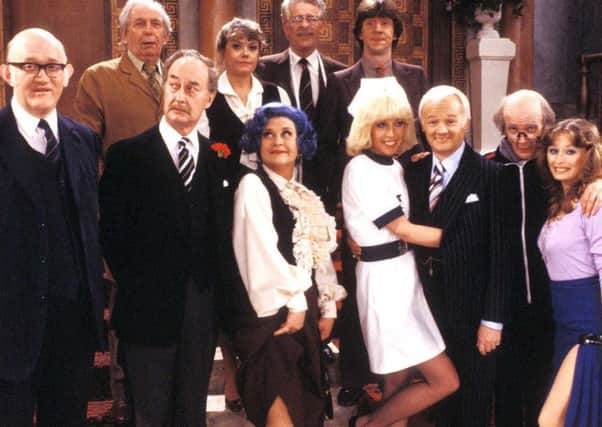Department store nostalgia won't save them '“ Jane Bradley


“It was a boardroom-level decision,” store manager Mr Rumbold pompously explains on iconic 1970s department store sitcom Are You Being Served?
And it always was. Just like retailers today, even the fictional Grace Brothers wasn’t immune from economic woes.
Advertisement
Hide AdAdvertisement
Hide AdOver the course of ten series, staff at the store find themselves at risk of redundancy and are forced to diversify to boost profits, in one memorable episode, setting up a cinema and nightclub on the shop floor. In another, perhaps most close to home for John Lewis employees, who were this week told they may not get their annual payout in March for the first time since 1953, Ernest Grainger and co have to fight for their bonuses, taking the complaint up as far as the Prime Minister before they are paid.
Everyone loves a department store. They are symbols of luxury, fascination and a world within themselves which perfectly lends itself to fictional portrayal. Inspired by writer Jeremy Lloyd’s time spent working in a similar store in London, Are You Being Served? boasted no less than 69 episodes – and has been named as one of the best British sitcoms of all time.
More recently, ITV drama Mr Selfridge attracted huge viewing audiences with its sumptuous portrayal of one of the UK’s best-known department store brands, while American children’s classic picture book Corduroy tells the sweet tale of a teddy bear on sale in a department store in the 1960s New York who explores the store at night after the shoppers have gone home.
It is the nostalgia of such places, the safe, comfortable feeling which they exude, which makes people intrigued by the inner workings. The popularity of this type of nostalgia is obvious in an exhbition dedicated to the historic department store at Dovecot Studios in Edinburgh which ends today.
Yet, figures would suggest that while we may love them – and we may want to hear about them – we do not shop in them as much as we once did.
My grandmother worked in the shoe department of Binns, a chain now owned by House of Fraser, and had happy memories of her time there. I remember being told about days gone by when the store, in a fairly run-down town, once had silver service and white linen tablecloths in its tea rooms: an occasional but regular treat for local shoppers who had no fast food chain or the attraction of a grande latte in Starbucks to lure them away from gentility. Even in my childhood in the 1980s, there was a bus boy who operated the lift in some local stores.
The department store represents an escape from the doldrums of day-to-day life. Some, many of which disappeared long ago, had more unusual means of attracting customers. In Edinburgh, Patrick Thomson’s had a restaurant with an in-house orchestra and once erected a 60ft golden ladder in store down which Santa Claus descended to mark the start of the Christmas shopping period. In Glasgow, Lewis’s, which closed in the 1990s, opened a menagerie of parrots and small animals in the 1950s.
Earlier this week, Ayr lost one of Scotland’s oldest department store brands. Hourstons – synonymous with the town’s high street since 1896 and one of few stand-alone retailers to be bought by House of Fraser but subsequently become independent again – is now set to close its doors on 7 February, with the loss of 81 jobs.
Advertisement
Hide AdAdvertisement
Hide AdManagement told staff that it was “merely a reality of retail today” that the store had to close, an echo of department stores bosses from House of Fraser’s Mike Ashley to John Lewis chairman Sir Charlie Mayfield, who have all warned of a tough retail climate in recent months. Many shoppers described Hourston’s closure as “sad”.
“Hourstons is closing and I feel like this is the end of an era,” said one shopper. “Both my Grans worked there, it’s where my mum, Gran and I have lunch every week.”
Yet, this Twitter user is fairly unusual: she actually visits the store every week. Most of us say we want to see department stores go on forever, but rarely actually use them. We claim it is sad when an independent retailer like this closes, yet many locals will not be able to remember the last time they went in there. Years ago, of course, this was not the case. In the wake of the closure of House of Fraser in Edinburgh’s West End, people lamented the sadness of the closure of a store which, in its era as “Binns”, had been “a meeting place on a Saturday night”.
In the modern era, however, department stores are finding it difficult to compete with the deals available online and those which did – such as John Lewis which has suffered from its ‘Never Knowingly Undersold’ promise which ties it to macthing prices any rival retailers have offered in store – are finding that such discounting hits their margins hard.
Some people who browse in physical shops don’t even necessarily buy the product they want there and instead go off and look for a deal online – a practice known as “showrooming”.
It’s the old adage that if we don’t use them, we lose them. And sadly for those with department store nostalgia, not to mention the people who work there, the retail tide doesn’t look set to move back towards using them.
